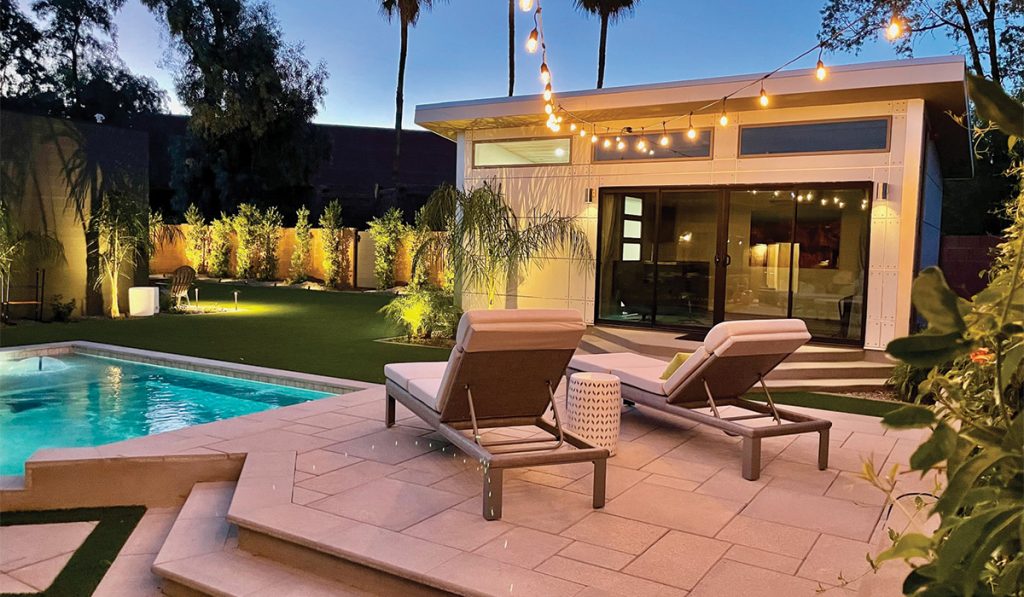 Phoenix appears to be poised to open the doors wider to accessory dwelling units (ADUs), and for good reason. These freestanding backyard structures — also known as in-law suites, granny flats, casitas and cottages — create additional living spaces at a cost of about 40% less than a traditional renovation or home remodel. With water, sewer and electrical service, ADUs are homes in their own right, and can be used as onsite rental properties or private living quarters for family members, guests and others.
Phoenix appears to be poised to open the doors wider to accessory dwelling units (ADUs), and for good reason. These freestanding backyard structures — also known as in-law suites, granny flats, casitas and cottages — create additional living spaces at a cost of about 40% less than a traditional renovation or home remodel. With water, sewer and electrical service, ADUs are homes in their own right, and can be used as onsite rental properties or private living quarters for family members, guests and others.
Other factors: The highest mortgage rates in 20 years are making moving more costly for those who are locked in at low rates. From an urban-planning perspective, ADUs provide a way of alleviating rental-market pressure by opening up low-profile, distributed housing that quietly preserves a neighborhood’s character. ADUs also bring rental income to homeowners and create additional housing in urban and close-in suburban areas where young professionals in particular gravitate, boosting density and energizing communities economically and culturally without imposing multistory structures on largely single-family neighborhoods. An added benefit for homeowners is, they have seen appraisal values rise as much as 35% with the addition of ADUs.
Phoenix’s single-family zoning codes already allow ADUs (though they’re called “guesthouses”), but that permission comes with limitations: They must be made of similar building materials and the same architectural style as that of the main unit. Also, the ADU can’t be advertised for occupancy, it can’t have separate mail service or a separate address, and it can’t be metered separately for utilities.
There’s a movement to update that zoning. The 2020 Housing Phoenix Plan, which aims to create or preserve 50,000 affordable homes by 2030 and boost overall supply, proposes to do just that, as does the Downtown Voices Coalition/Arizona Preservation Foundation’s Gentle Density Study, which advocates for ADUs.
With all that as background, let’s talk about some specifics about ADUs. I’ll focus on prefabricated units, which comprise most of the U.S. market now.
Why go with a prefab ADU versus an onsite build? Prefab construction happens quickly in the factory (typically in three to four weeks once permitting is secured) and proceeds with minimal disruption at the customer site. Cost savings are another big benefit. High-volume, factory-based prefabrication under one roof streamlines the production of ADUs and allows customizable production at scale while avoiding supply-chain, labor, and inflation challenges typically faced by general contractors and local design-build firms. ADUs also avoid expensive architecture and design fees associated with one-off onsite builds.
Speaking of permitting: How does that work? Given the rising popularity of ADUs, zoning and permitting vary from market to market and even within a particular market. Plus, municipalities are increasingly open-minded about ADUs, making zoning a moving target. Good news is experts at prefab ADU makers will clarify the local rules and help customers navigate the permitting process.
Are prefab ADUs customizable? Yes. Prefab ADU manufacturers offer online design studios that allow for a great deal of flexibility in an ADU’s final look and feel, from interior layouts and finishes to windows to doors to exterior paneling.
How are prefab ADUs shipped? ADUs are typically shipped using two or three large pallets, including fully panelized wall sections, preframed roof sections, prepainted siding, and prehung operable and fixed windows. The pallets are delivered using regular freight-transport networks.
Who does the onsite prefab ADU installations, and how long does it take? Onsite assembly and installation of an average-sized ADU by certified installers typically takes four to five weeks, depending on options, complexity and site conditions. If a customer chooses a DIY approach, prefab ADU makers offer guidance throughout the process.
Phoenix can get toasty. How do ADUs do on the energy-efficiency and insulation fronts? ADU building envelopes typically include above-code insulation and weatherizing with such features as Zip System wall sheathing, OSB with rubberized membranes, and ultrahigh-efficiency doors and windows. They comply with strict building-code standards, such as California’s Title 24 Building Efficiency Standards, which, among other requirements, demand that additions and new homes — including ADUs — have enough solar panels to achieve net-zero energy consumption.
ADU building envelopes typically include above-code insulation and weatherizing with such features as Zip System wall sheathing, OSB with rubberized membranes, and ultrahigh-efficiency doors and windows. They comply with strict building-code standards such as California’s Title 24 Building Efficiency Standards, which, among other requirements, demand that additions and new homes – including ADUs – include enough solar panels to achieve net-zero energy consumption.

Jeremy Nova is a national ADU expert and co-founder of Studio Shed, a leading modular home builder since 2008.














Speak Your Mind
You must be logged in to post a comment.